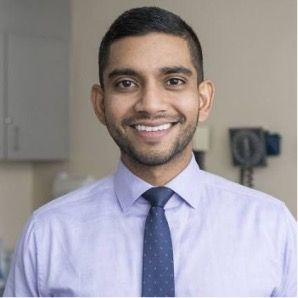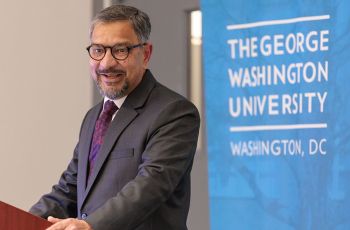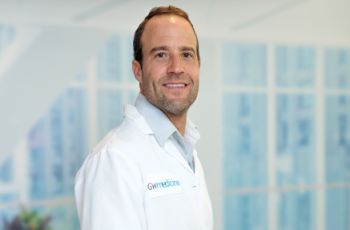
Cutaneous oncologist Vishal Patel sees the world from very different planes: with an interest in global health, he has a big-picture view of the impacts of skin cancer, and as a renowned Mohs micrographic surgeon, his perspective is very granular. In between, he’s a husband and dad who loves great wines and hip-hop.
What’s your story?
My trajectory was different from that of most medical students who pursue training in dermatology. Dermatology wasn’t even on my radar. I wasn’t even sure I wanted to go into clinical medicine because I was interested in public policy and global health issues. I went into internal medicine with the goal of focusing on global health and HIV, and I did some work in sub-Saharan Africa in that area. I developed an interest in Kaposi sarcoma, which occurs in HIV patients.
While I was a resident at Columbia University, I worked with Dr. Marc Grossman, a brilliant internist and dermatologist. He’s an expert in skin infections in compromised hosts and encouraged me to pursue global health as a dermatologist rather than an internist. I made the switch to dermatology and then pursued a fellowship in micrographic surgery and dermatological oncology. Making the shift from internal medicine to dermatology was such an ah-ha moment for me. It opened the door to a fascinating, focused, and very fulfilling field of medicine.
What gets you out of bed in the morning?
On a practical level, it’s my kids. (Two boys, ages almost eight and four.) It’s the day-to-day of raising two boys with my wife, Ilana DeLuca, who is also a dermatologist with the MFA (GW Medical Faculty Associates). Together, we’re making our family’s and children’s lives better and, by extension, our patients' lives better. It’s a complete circle.
But as a whole, it’s what we do here at GW Cancer Center. It’s been remarkable watching the oncology world change and the big jumps we’ve made in treating skin cancer, especially with the advent of immunotherapy. Ten years ago, melanoma felt like a death sentence for most; just look at Jimmy Carter, who was not my patient but whose case I followed closely. He had metastatic melanoma in his brain and has had a complete remission due to immunotherapy. And now we have therapies for advanced squamous cell carcinoma that previously we had nothing for, but now we can melt away tumors that are the size of melons! The future potential is very exciting, and we are leading the charge here at GW, and I can provide my patients with those treatments that are advancing every day.
What’s that one book that has influenced you the most?
As an oncologic-focused clinician, The Emperor of All Maladies is a great book that all budding oncologists should read – it provides great context around the field of oncology. I knew [the author] Siddhartha Mukherjee when I was at Columbia, and he gave me a signed copy when I completed my dermatologic oncology fellowship, so I hold that near and dear to my heart. But honestly, I’m much more of a music person than a book person, especially since I am listening to new and old tunes while operating each week.
There’s just so much good and great music, and it is fun exposing my boys to what are now classics from decades ago. I love jazz – that is a staple in our house. I think the best expression of jazz is its intersection with early hip-hop. A Tribe Called Quest is my favorite hip-hop band, and we are coming up on the 35th anniversary of The Low End Theory, which is arguably one of the greatest albums of all time. The music fuses jazz, hip-hop, and lyricism in a way that is just transforming – and the Library of Congress selected it for preservation in the National Recording Registry last year. Every time I listen to it, I hear nuances or influences from early jazz I haven’t heard before. It’s as if I’m hearing it for the first time every single time.
You and your work have made a difference for many patients. Is there one patient who made a difference for you?
No, there isn’t one single patient – but I think that is a good thing! Just like life experiences, different patients and different time points have important roles in your evolution as a provider. I have deep connections to so many of them and their families and I’m struck by the goodness in people, especially when they’re facing a dire prognosis. But even the patients with simpler diagnoses or one-off problems or interactions – I find comfort in those special and kind interactions I have, when least expected, with patients I may know well or may only meet once, because that is what keeps me going. It’s what reminds me of what we do as providers – and what makes us feel connected as human beings sharing in existence. So, while there are certainly remarkable clinical cases and therapeutic results that might stick in my head, the patient experiences can be impactful without being so dramatic, and it really only takes one good one to energize you for the day and for what we do.
What is the most interesting thing we should know about you?
I’m an obsessive wine collector. When I was a resident and a fellow, I started to study to be a sommelier. I haven’t followed up on it, but when people ask me what I want to do when I retire, the answer is to retire early enough to have either a career or hobby in the wine world. I have many good friends who live and breathe in that world and have influenced me. My wife thinks this is a very expensive and annoying hobby – we have about 500 bottles stored in the basement. I have bottles that commemorate special occasions throughout our life together: anniversaries and when our boys were born. I have enough “birth year” bottles to open one for every special year of their lives moving forward – to celebrate graduations, when they get married, buy their first house, or start having their own kids. And they’ll be aged 20 or 30 or 40 years by the time they’re opened. It takes a lot of planning and organization, but it pays off over time. The bottle that I can’t wait to open is one I bought the year my wife and I were married. It’s a 2015 Château Margaux, which was the last vintage [winemaker] Paul Pontalier produced before he passed away, and is etched in gold. That’s reserved for our 40th or 50th wedding anniversary, and for so many reasons, this will be memorable and amazing.



